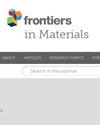Microstructure versus topography: the impact of crystallographic substrate modification during ultrashort pulsed direct laser interference patterning on the antibacterial properties of Cu
IF 2.6
4区 材料科学
Q3 MATERIALS SCIENCE, MULTIDISCIPLINARY
引用次数: 0
Abstract
Introduction: Topographic surface patterning in the micro- and nanometer scale has evolved into a well applied approach in surface functionalization following biomimetic blueprints from nature. Depending on the production process an additional impact of process-related substrate modification has to be considered in functional surface optimization. This is especially true in case of antimicrobial applications of Cu surfaces where a modification of the substrate properties might impact bactericidal efficiency.Methods: In this regard, the effect of ultrashort pulsed direct laser interference patterning on the microstructure of pure Cu and resulting antimicrobial properties was investigated alongside line-like patterning in the scale of single bacterial cells.Results and Discussion: The process-induced microstructure modification was shown to play an important role in corrosion processes on Cu surfaces in saline environment, whereas the superficial microstructure impacts both corrosive interaction and ion emission. Surprisingly, antimicrobial efficiency is not predominantly following deviating trends in Cu ion release rates but rather depends on surface topography and wettability, which was shown to be impacted by the substrate microstructure state, as well. This highlights the need of an in-depth understanding on how different surface properties are simultaneously modulated during laser processing and how their interaction has to be designed to acquire an effective surface optimization e.g., to agitate active antimicrobial surface functionalization.微观结构与形貌:超短脉冲直接激光干涉图案化过程中晶体基底改性对铜抗菌特性的影响
导言:微米和纳米尺度的表面拓扑图已经发展成为一种应用广泛的表面功能化方法,它遵循的是来自大自然的生物仿生蓝图。根据生产工艺的不同,在功能表面优化过程中还必须考虑与工艺相关的基底改性所带来的额外影响。尤其是在铜表面的抗菌应用中,基底特性的改变可能会影响杀菌效率:方法:在这方面,研究了超短脉冲直接激光干涉图案化对纯铜微观结构的影响以及由此产生的抗菌特性,同时还研究了单个细菌细胞尺度下的线状图案化:在盐水环境中,工艺引起的微观结构改变在铜表面的腐蚀过程中发挥了重要作用,而表层微观结构对腐蚀作用和离子发射都有影响。令人惊讶的是,抗菌效率并不主要遵循铜离子释放率的偏离趋势,而是取决于表面形貌和润湿性,而这也受到基底微观结构状态的影响。这突出表明,需要深入了解激光加工过程中如何同时调节不同的表面特性,以及如何设计它们之间的相互作用,以获得有效的表面优化,例如促进活性抗菌表面功能化。
本文章由计算机程序翻译,如有差异,请以英文原文为准。
求助全文
约1分钟内获得全文
求助全文
来源期刊

Frontiers in Materials
Materials Science-Materials Science (miscellaneous)
CiteScore
4.80
自引率
6.20%
发文量
749
审稿时长
12 weeks
期刊介绍:
Frontiers in Materials is a high visibility journal publishing rigorously peer-reviewed research across the entire breadth of materials science and engineering. This interdisciplinary open-access journal is at the forefront of disseminating and communicating scientific knowledge and impactful discoveries to researchers across academia and industry, and the public worldwide.
Founded upon a research community driven approach, this Journal provides a balanced and comprehensive offering of Specialty Sections, each of which has a dedicated Editorial Board of leading experts in the respective field.
 求助内容:
求助内容: 应助结果提醒方式:
应助结果提醒方式:


